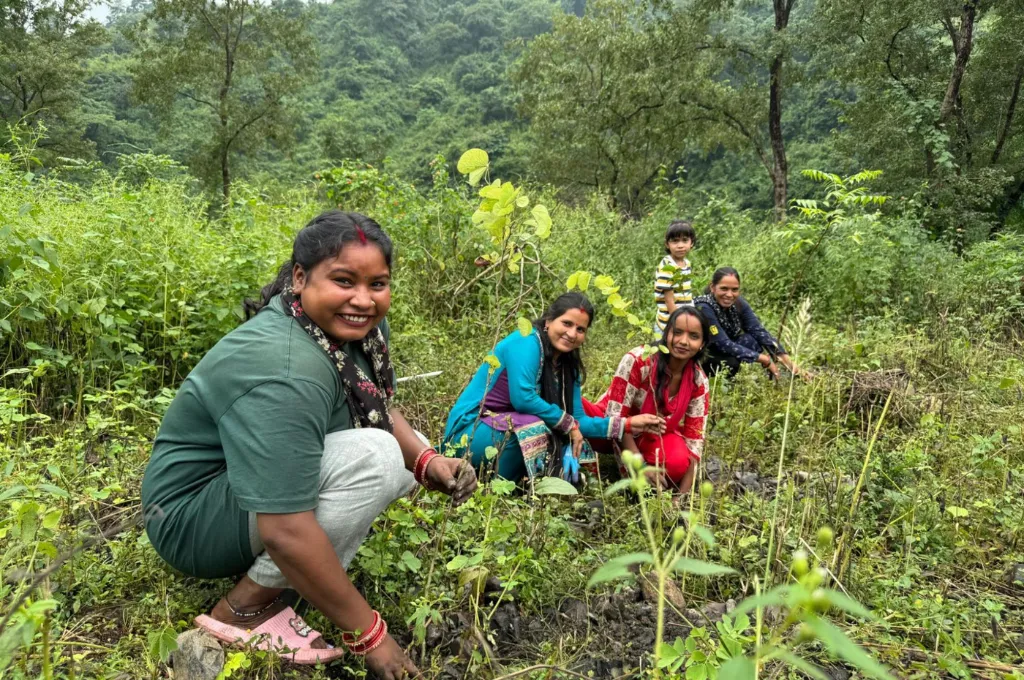What is a circular economy?
Circular economy or circularity is a system designed to minimise waste and maximise resource efficiency. This is achieved through its three core principles: eliminating waste entirely, circulating products and materials in a closed loop, and supporting regeneration. This means products are kept in continuous circulation and are reused and repaired which reduces the need to extract new resources.
This in contrast to linear economy, which is the current model followed around the world, which promotes producing and selling as much as possible. This has led to the indiscriminate extraction of finite natural resources, giving rise to unprecedented amounts of waste and carbon emissions that have exacerbated the climate crisis. A UN Environment report states that resource extraction has more than tripled globally since 1970. If the global population grows to 9.8 billion by 2050, nearly three earths’ worth of natural resources would be needed to maintain current living standards.
A circular economy, on the other hand, creates a closed loop or circular system where products are made better and used longer, producing long-term environmental and economic benefits. Unlike recycling, which begins at the end of a product’s life—often with limited impact at scale—a circular economy ensures that, from the outset, products are designed in a way that maximises usage and minimises wastage throughout their life cycle. It is also regenerative and restorative by design. Restoration and regeneration imply that after their life cycle ends, materials used to make a product can seamlessly merge with natural systems, becoming resources again. For example, in food systems, organic waste like food scraps can be used as animal fodder or composted to regenerate soil health, enriching it with nutrients and promoting sustainable agriculture. In the textile sector, fabrics can be broken down into raw fibers and respun to produce new textiles, reducing the need for virgin materials. Similarly, in construction, materials such as concrete, steel, and bricks can be reclaimed and reused in new building projects, decreasing the demand for raw resource extraction.
A circular economy also supports the repair and refurbishment of damaged products by designing them in a way that allows for repairs, rather than requiring them to be trashed like most cell phones today.
In order to work well, circularity requires a systems lens, which uncovers the interconnections vital to understanding and building a circular economy. These include supply chains, consumers, producers, suppliers, and policymakers.
A systems lens to circularity involves:
- Thinking about products and the actors around them as part of networks, rather than chains
- Thinking about new value networks and new actors within it, such as repairers and refurbishers
- Thinking about innovating technologies and sustainable products
- Thinking about just transition for each product
- Thinking about changing consumer behaviour
Why do we need a circular economy?
By 2050, global waste is expected to increase by 70 percent, rising from 2.01 billion tonnes in 2016 to 3.4 billion tonnes annually. Currently, India alone generates approximately 62 million tonnes of waste every year.
Overconsumption and overproduction are key contributors to increasing levels of waste. Rampant consumerism has seen a swift rise, liked as it is to the accelerating rate of population growth in urban areas. This further strains natural resources. By 2036, 40 percent of India’s population will live in urban areas, a demographic shift that bolsters the case for sustainable modes of production and consumption.
It is imperative, therefore, that India adopt a development model that reduces its dependence on natural resources and mitigates its waste production—in other words, take the circular approach, which has multiple advantages.
1. Resource self-sufficiency
A case in point is India’s mobile phone production, which grew 2,000 percent over a decade. As cellular technologies become quickly obsolete, consumers buy new devices, fuelling consumption.
Rechargeable phone batteries require minerals such as lithium and cobalt (as do green technologies such as solar panels, wind turbines, and electric cars). India however lacks significant lithium and cobalt reserves, and is dependent chiefly on external markets. If the metals and minerals from discarded phones and laptops can be recovered and reused, not only will the country’s dependency on imports reduce, but its mounting e-waste problem will also be tackled and its green transition will become sustainable.
2. Slowdown of climate change
The 2021 Circularity Gap Report points out that material extraction is responsible for 70 percent of current greenhouse gas (GHG) emissions. A circular economy will help mitigate climate change by reducing resource extraction. In a working paper, India’s Economic Advisory Council to the PM estimates that a circular economy could lower India’s GHG emissions by 23 percent in 2030 and by 44 percent in 2050 at the current rate of development. However, at the current rate of consumption, the world is becoming less circular. The 2024 edition of the Circularity Gap Report says that the use of secondary materials in the global economy has in fact declined from 9.1 percent in 2018 to 7.2 percent in 2023.
3. New jobs and a strengthened economy
In addition to helping build low-carbon economies, circularity creates new job opportunities by opening up new value networks and sectors. According to the International Labour Organization, circular models of economy can create 6 million jobs globally by 2030. A report by FICCI highlights that a shift to a circular economy is a USD 500 billion opportunity. Servitisation and utilisation of waste as raw material are two ways in which this shift can be facilitated.
- Servitisation implies that producers sell services instead of products, eliminating the need for consumers to own the latter. Some successful examples include Ola and Uber that provide cars as a service, and Netflix and other OTT platforms that offer entertainment as a service. Infinity Box offers food packaging as a service by supplying customers with returnable boxes via food delivery platforms such as Swiggy and Zomato.
- The utilisation of waste as raw material opens up another avenue for economic growth. For example, coffee husk, a by-product of processed coffee that is usually thrown away, can be used to make cascara, a type of coffee cherry tea. The creation of a new, value-added product opens up a whole new line of income opportunities for everyone—from farmers to processors, logistics operators, and retailers. In this way, a circular economy makes room for new stakeholders to enter the value network at different stages and create ways to utilise materials, products, and by-products, fostering new types of businesses and localised systems of exchange.

How is circular economy currently practised?
In India, two main pathways to circularity have emerged—regeneration and reuse, and increasing the longevity of the product itself. Both approaches require producers to recalibrate their business models, production, and value networks.
- Regenerating and reutilising resources: The apparel industry, which produces huge amounts of waste, is exploring new material sources in a bid to reduce this waste. Golden Feathers, for instance, produces winter wear using chicken feathers from butchery waste. Sirohi, a lifestyle brand that employs women artisans, converts textile and multilayer plastic waste into products such as baskets and boxes.
- Extending the longevity of products: This approach entails designing and manufacturing durable and sustainable products, which may require manufacturers to source new, long-lasting materials. Longevity is also achieved through repair and refurbishing. Doodlage, an Indian apparel brand, creates products from textile waste, and extends the lifespan of the garment by providing repair and alteration services to customers. This builds a new value chain of resale, repair, and refurbishing.
A comprehensive transition to circularity is a long and complicated process, which is why manufacturers have adopted incremental shifts in supply chains and operations. Moreover, circularity and its adoption may mean different things for different sectors. For instance, circularity may look very different for food systems that integrate natural farming (such as in Andhra Pradesh) than it does for tech companies.
Policies and regulations can help standardise circular practices. Here are examples of policies that can advance circularity in India:
- Extended producer responsibility (EPR): Under this policy, launched in 2011, businesses that operate in India and generate waste such as plastic, e-waste, batteries, tyres, and used oil must comply with EPR regulations. This includes meeting prescribed targets for reuse, recycling, using recycled materials, refurbishment, and end-of-life disposal. Defaulters are liable to be fined.
- Right to Repair: This principle grants consumers the right to repair their products without facing restrictions or technical limitations from manufacturers. Under this framework, manufacturers will be required to provide customers with product details, enabling them to repair items themselves or through third-party services, rather than rely solely on original manufacturers.
- National Resource Efficiency Policy (NREP): Drafted in 2019 by the Ministry of Environment, Forest and Climate Change, the NREP aims to create a circularity framework for key sectors such as the automotive, plastic packaging, construction, and electronic sectors. It will do so via sector-specific action plans, economic incentives, and public awareness campaigns.
- Circularity in construction: The government of Karnataka is launching a policy that mandates that 20 percent of all construction material used in the state be sustainable.
How can manufacturers design for circularity?
There is no one-size-fits-all approach when it comes to adopting circular models. However, a good starting point would require manufacturers to answer a set of fundamental questions: What is the raw material used? What waste is generated during production and after consumption? Is the product durable? Answering these reveals key features that can help build circular models. We delve into each of these aspects below.
Materials: When designing a product and its packaging, it’s essential to consider their impact over their entire life cycle, that is, production—use—disposal. Materials used should be either regenerative or recyclable to prevent them from ending up in a landfill when discarded. Regenerative materials can naturally replenish over time, while recyclable materials can be reprocessed for new uses. However, even when regenerative materials such as natural fabrics are used, the addition of toxic chemicals during processing can compromise their ability to regenerate. Coatings, dyes, and chemical treatment may alter the material’s natural properties, making it harder to biodegrade or recycle effectively.
Many food manufacturers in India use multilayered packaging material that combines plastic and aluminum foil. However, most recycling facilities are designed to process single-material plastics and find it challenging to separate mixed materials, which results in abysmally low recycling rates and leads to large amounts of unprocessed waste. By one estimate only 9 percent of all the plastic generated globally is recycled.
Supply and value networks: Rethinking supply and value networks is another important piece in this puzzle. A clothing brand that wants to create sustainable clothes may seek to collaborate with suppliers who work with ethically sourced and sustainable material, right down to the yarn, and with designers who minimise fabric waste and find creative solutions for leftover material. They may add additional links to their value network by collaborating with recyclers and repair specialists, and in the process develop or support new businesses.
Collaborations: There is scope for sustainable and mutually beneficial collaborations across supply networks when stakeholders partner up and share knowledge and strategies with one another. Cotton farmers who often live next door to food farmers can form such a partnership where by-products from one farm support the other. For example, processed cotton waste (such as seeds) can be used for animal feed or for oil production, while food crop residue can serve as inputs for bio-based materials in textile production. Such collaborations between the food and textile sectors demand context-specific interventions to build circularity, but these partnerships can lead to transformative and sustainable impacts.
Costs: Any disruption in the value chain and introduction of new elements may lead to higher costs of production. In such a scenario, it is important to ensure that the risks and costs are equitably shared and that the cost of the transition does not fall disproportionately on any single stakeholder group.
Technology: Technology helps increase the accuracy of commodity, consumer, and market data. It can create more accurate forecasts for the production of certain goods and prevent overproduction. The Digital Product Passport (DPP), for example, enables better visibility on a product throughout its life cycle. Product data—including details on raw materials and the manufacturing process—is recorded on the DPP and shared with various stakeholders throughout the supply chain.
What are the challenges to adopting circularity?
Challenges to building a circular economy arise on multiple fronts, but the key ones relate to behaviour change and policy implementation across the value network.
1. Behaviour change
a. Consumers: It’s more convenient to throw a product away and buy a new one than to ensure its longevity or that it re-enters the cycle of production. A linear economy incentivises people to be wasteful as cheaper goods are easily affordable, discarded, and replaced. In fast fashion, for instance, the low cost of production, fuelled by credit-driven capitalism and economies of scale, makes it easy for consumers to buy and discard more garments, unmindful of the environmental consequences. Approximately 100 billion garments are produced each year, and 92 million tonnes end up in landfills. Similarly, in the electronics sector, consumers are drawn to new gadgets, unaware of the environmental cost of mining the minerals and metals required to produce them. India is one of the largest producers of e-waste, with 1.6 million tonnes produced in 2021.
Shifting consumer behaviour requires structural changes that make sustainable choices easy to execute and rewarding. The onus is therefore also on producers and local authorities to enable and enforce sustainability. Indore is a good example of this. The city has the best waste management credentials in the country, made possible not only through waste segregation, door-to-door collection, and waste processing systems, but also through systemic changes and behaviour change campaigns.
b. Manufacturers and suppliers: Suppliers may resist circularity, as it could reduce production and render their investments in technology and assets obsolete. Players at the initial stages of the supply chain (upstream) may view a shift to circularity as a disruption to their value propositions and a threat to their existing roles. On the other hand, players involved in later stages of production and distribution (downstream) may find it challenging to align circularity with consumer behaviour. This may demand significant effort and engagement.
In addition to this, a shift to a circular economy might have high initial costs for manufacturers. To address this, it’s crucial to create an inclusive transition where all stakeholders are supported and can adapt to new business models. This requires changes in the financing space with more financing options available to players looking to shift to circularity.
2. Policy and regulations
Governments play a crucial role in creating conditions for a circular economy to thrive. While India’s policy landscape has made efforts to promote the recycling economy, sufficient incentives and informed policies to promote a circular economy are still lacking. The ban on single-use plastics, for instance, has led to an increase in the use of paper bags as a ‘green’ alternative. However, these alternatives have not yet been subjected to a life-cycle analysis to determine if they’re regenerative or can be reused. Until recently, EPR rules only regulated plastic in packaging material. However, draft EPR rules released in December 2024 include paper, metal, and glass as well.
We also need rules for the standardisation of materials used in products and packaging to help facilitate their reuse, recycling, and integration into new production cycles.
The Ellen MacArthur Foundation highlights other policy recommendations in its report Universal Circular Economy Policy Goals (2021). Some of these are: supporting blended finance solutions for physical and digital infrastructure and innovation; creating tax and procurement policies that foster repair, sharing, resale, and remanufacturing to maximise asset use and return on invested energy; and developing secondary material and by-product markets.
In sum, by reimagining and inventing new production and consumption patterns, we can promote resource efficiency and reduce dependence on finite natural resources. The circular economy thus plays a crucial role in fostering climate-resilient and sustainable markets, complementing broader efforts to mitigate climate change.
Halima Ansari and Joeanna Rebello Fernandes contributed to this article with inputs and insights from Aarti Sachdeva, Neil Walker, and Shubhi Sachan.
—
Know more
- Learn more about the concept of Design for Environment, which helps assess the environmental impact of production.
- Read this report by Ellen MacArthur foundation to learn more about policies related to circularity.
- Learn why we need to build a circular economy for India’s renewable energy value chain.





